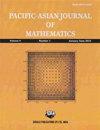模微分算子的指数
IF 0.7
3区 数学
Q2 MATHEMATICS
引用次数: 0
摘要
将模群的所有弱全纯模形式的空间和所有全纯定权周期函数的空间实现为拓扑对偶的局部凸拓扑向量空间。利用这个框架研究了保持模性的线性微分算子的核和值域,并定义和描述了它的伴随算子。主要的结果是一个在无穷远处全纯的微分算子的指标公式。该算子的协核被标识为作用于该核的模群的上同调群。本文章由计算机程序翻译,如有差异,请以英文原文为准。
The index of a modular differential operator
The space of all weakly holomorphic modular forms and the space of all holomorphic period functions of a fixed weight for the modular group are realized as locally convex topological vector spaces that are topologically dual to each other. This framework is used to study the kernel and range of a linear differential operator that preserves modularity and to define and describe its adjoint. The main result is an index formula for such a differential operator that is holomorphic at infinity. The co-kernel of the operator is identified as a cohomology group of the modular group acting on the kernel.
求助全文
通过发布文献求助,成功后即可免费获取论文全文。
去求助
来源期刊
CiteScore
1.30
自引率
0.00%
发文量
93
审稿时长
4-8 weeks
期刊介绍:
Founded in 1951, PJM has published mathematics research for more than 60 years. PJM is run by mathematicians from the Pacific Rim. PJM aims to publish high-quality articles in all branches of mathematics, at low cost to libraries and individuals. The Pacific Journal of Mathematics is incorporated as a 501(c)(3) California nonprofit.

 求助内容:
求助内容: 应助结果提醒方式:
应助结果提醒方式:


